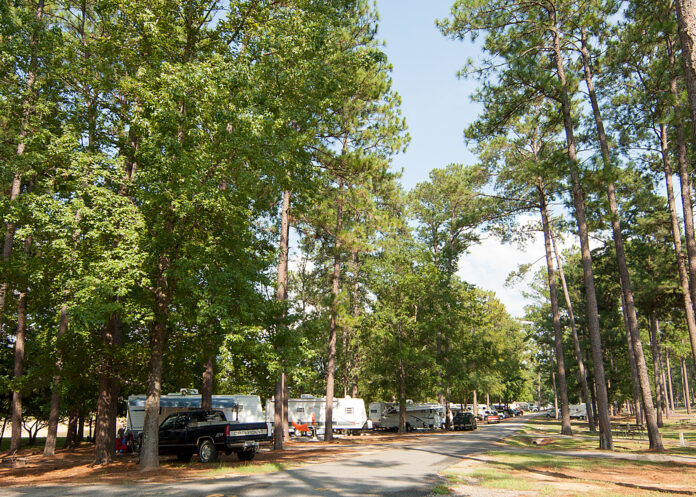MONTGOMERY, Ala. – By a wide margin, Alabama voters approved the amendment on last Tuesday’s ballot to provide as much as $80 million in funding for improvements and enhancements to Alabama’s 21 state parks.
“I would like to thank the voters of Alabama for their overwhelming support of our beautiful state parks,” said Chris Blankenship, commissioner of the Alabama Department of Conservation and Natural Resources (DCNR). “This will give us the funds to make much-needed improvements to the campgrounds across the state, bringing them into the 21st century. A lot of our campgrounds were built when camping was a pop-up camper and a tent. We’re way past that now with the larger motorhomes with three air conditioners that need 50-amp service. We want to make sure we provide for citizens and our guests moving forward. Our day use areas need some new bathroom facilities to try to expand the day use in our parks. We want to build some accessible playgrounds so that our citizens of all ability types will have the opportunity to play at our playgrounds and enjoy our parks.
“We have parks that don’t have cabins. If people don’t have an RV or motorhome, they are not able to enjoy our parks as much as we would like. Our State Parks have been very successful the last few years under (Director) Greg Lein and our new Deputy Director Matthew Capps. Every dime we make at the parks we put back into the parks to do good work.”
During last weekend’s Alabama Conservation Advisory Board (CAB) meeting at Lakepoint State Park in Eufaula, Commissioner Blankenship welcomed Governor Kay Ivey, who won Tuesday’s Republican nomination without a runoff, to the Board meeting and highlighted her accomplishments in outdoor recreation.
“In the time that Governor Ivey has been in office, we (DCNR) have acquired 63,000 acres of property that has gone into public ownership for conservation and enjoyment of our citizens forever,” Commissioner Blankenship said. “Thank you, Governor, for your leadership in allowing ADCNR to do good work for the people and natural resources of Alabama. In my 28 years at Conservation, I don’t ever remember a governor joining us at one of our CAB meetings.”
Governor Ivey highlighted the impact outdoor recreation has on Alabama’s economy as well as reiterating her support for State Parks.
“Hunting, fishing, hiking and outdoor recreation, as managed by the Department of Conservation and Natural Resources, is a $14 billion, with a B, economic driver for our state,” Governor Ivey said. “That’s especially important for rural areas. I thank the men and women of the DCNR for their hard work and their passion that they display every day to ensure we have fish, wildlife and access to public lands and waters, both today and tomorrow for future generations. Conservation also manages our beautiful Alabama State Parks, many of which I’ve had the pleasure of visiting. With this bond money, we can make the needed improvements and upgrades to our state parks.
“One thing is for sure, in a state like Alabama, folks are passionate about hunting, fishing and wildlife, and they have plenty of opinions of how they should be managed. Commissioner Blankenship and his team do a wonderful job of balancing long seasons with appropriate bag limits to ensure that we don’t overharvest the bounty that God has blessed us with. Alabama is truly a great place to hunt, fish, camp, hike and spend time in the great outdoors. So, y’all keep up the good work so that we remain Alabama the beautiful. Thank you for having me today, and may God bless each of you and the great state of Alabama.”
State Parks recently held ribbon cuttings at several parks, including Cathedral Caverns, where a new campground was opened. State Parks worked with the Alabama Department of Environmental Management (ADEM) to use rubberized asphalt to pave roads and parking lots at Guntersville State Park. The Joe Wheeler State Park campgrounds that were destroyed by a tornado in 2019 have reopened, and a project at DeSoto Falls included dredging an area of the river there and a new beach for the day-use area. The rubberized asphalt will be used to pave the roads and parking lots at the day-use area. Also, all 1,300 overnight units at State Parks received new mattresses.
“We also recently celebrated an addition of 1,650 acres (Belcher Tract) at Oak Mountain State Park, the largest park in our system, right there in fast-growing Shelby County,” Commissioner Blankenship added. “That was monumental. That was purchased by the Forever Wild Land Trust, which is managed by State Lands and Director Patti McCurdy. You don’t get those opportunities very often, and I’m thankful to the Forever Wild Board for moving on that.”
Commissioner Blankenship also provided an update on the effort to rebuild the portion of Gulf State Park Pier that was demolished by Hurricane Sally in 2020. The bids to do the work far exceeded expectations from the engineers.
“We thought the bids would come in between $4 million and $6 million; that was the estimated range from the engineering firm,” he said. “The lowest bid ended up being $12.5 million, so it was more than twice what we thought would be the high bid. We’re working with FEMA to get approval for the new amount. We’re not going to be shutting the pier down this summer to do the construction that we had planned. We’ll have to bid that again in late summer or early fall once we get the FEMA approvals.”
Alabama’s private recreational red snapper season opened Friday for four-day weekends (Friday-Monday) until the quota of 1.12 million pounds is expected to be reached.
“Just for information for the Board, NOAA Fisheries recently announced the South Atlantic red snapper season for 2022,” Commissioner Blankenship said. “It will be July 8 and 9. That is their season—two days. The work that Marine Resources Division Director Scott Bannon and Kevin (Anson, MRD Head Biologist) and their team have done with other Gulf states has made a huge difference. Had that work not taken place, our season in the Gulf would probably be two days. Our season last year was 124 days. That just shows tangibly that the work they do means so much for the economy and outdoor recreation in Alabama.”
Bannon said Alabama’s private recreational anglers will have an unusual opportunity during the Memorial Day Weekend to catch three of the state’s iconic offshore species—red snapper, greater amberjack and gray triggerfish. Triggerfish and amberjack seasons are open through May 31. Anglers are required to report the harvest of all three species through the Snapper Check feature on the Outdoor AL app.
“We call it the trifecta weekend for reef fish where you can catch all three species,” Bannon said. “If you plan to come to the Gulf Coast this weekend, the boat ramps will be congested, which is about the nicest word I can use. Bring your patience with you.
“Also, this year, reef fish fishermen must have a venting tool or descending device to reduce the number of dead discards.”
Bannon provided the Board with updates on recreational saltwater fishing license sales, red snapper and a much-improved oyster season. More than 140,000 recreational saltwater licenses were purchased for the current season.
“A lot of people are visiting the Gulf, and a lot of people are moving there,” Bannon said. “The increase in license sales reflects that. The Gulf Reef Fish Endorsement ($10 license) was created three years ago. We sold 23,000 the first year and more than doubled to 56,000 the second year. That helps identify the anglers participating in offshore reef fish fishing and those funds go directly to enhancing and managing offshore reef fisheries.”
Bannon also highlighted the recent work to expand Alabama’s already unparalleled artificial reef program. About 1,200 square miles off the coast of Alabama is designated artificial reef zones. The reef zones were increased about 115 square miles recently with the addition of the Christopher M. Blankenship Zone and additions to several nearshore reef zones. In the overall reef zone complex, MRD deployed 456 25-foot pyramid modules, 1,203 juvenile reef fish modules, 327 circalittoral (nearshore) modules and built four new inshore reefs.
MRD has also spent more than $10 million in recent years on oyster restoration, including the planting of cultch material and starting a “mounds and furrows” project that provides the oysters some relief from low-oxygen areas on the bottom.
“Oysters are not only important to catch and eat, I call them the foundational critters,” Bannon said. “In the estuaries, we need those oysters. They clean the water. They’re a sign of a healthy water system. They feed other species out there. Without oysters, the whole system is out of balance.”
The success of these oyster restoration efforts is revealed in the number of sacks oyster catchers have produced in recent years. The harvest went from zero for the fall 2018 through spring 2019 season to 11,333 sacks the following year. In the fall 2020 through spring 2021 season, 22,070 sacks were brought to market. In the most recent season, 50,020 sacks were harvested. That translates into more than $4 million going into the pockets of the oyster harvesters.
“With the grid system, we can close one 500-meter area at a time,” Bannon said. “Our original harvest estimate for 2022 was 22,000 sacks. We harvested more than 50,000 because we could keep the catchers moving to new areas, and that also keeps from overharvesting certain areas. They quickly figured out the benefit to them and the oyster reefs.”
On the Wildlife and Freshwater Fisheries (WFF) side, the Alabama Legislature passed legislation to create an enclosure gun deer season. It sets the hunting dates for those enclosures that opt into that season, which will be October 15 through January 6.
The Board also voted to allow the use of turkey decoys during the special youth and disabled hunting dates. For 2023 in Zones 1 and 3, those dates are March 17 and 18 for youth and March 24 for disabled hunts. In Zone 2, the dates are March 25 and 26 and March 31.





















